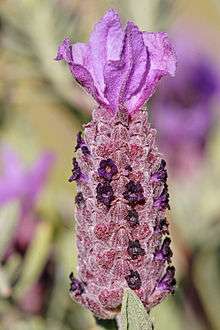Lavandula stoechas
| Lavandula stoechas | |
|---|---|
 | |
| Lavandula stoechas flowers | |
| Scientific classification | |
| Kingdom: | Plantae |
| (unranked): | Angiosperms |
| (unranked): | Eudicots |
| (unranked): | Asterids |
| Order: | Lamiales |
| Family: | Lamiaceae |
| Genus: | Lavandula |
| Species: | L. stoechas |
| Binomial name | |
| Lavandula stoechas L. | |
Lavandula stoechas (French lavender, Spanish lavender, or topped lavender) is a species of flowering plant in the family Lamiaceae, occurring naturally in Mediterranean countries.
Description
An evergreen shrub, it usually grows to 30–100 cm (12–39 in) tall and occasionally up to 2 m (7 ft) high in the subspecies luisieri. The leaves are 1–4 cm long, greyish and tomentose.
The flowers, which appear in late spring and early summer, are pink to purple, produced on spikes 2 cm long at the top of slender, leafless stems 10–30 cm (4–12 in) long; each flower is subtended by a bract 4–8 mm long. At the top of the spike are a number of much larger, sterile bracts (no flowers between them), 10–50 mm long and bright lavender purple (rarely white).[1]
Subspecies
The recognised subspecies are:
- L. stoechas pedunculata, the common type specific plant, once taxonomically considered L. pedunculata. There is considerable variation in this subspecies, and it may be split into a number of distinct forms. It is native to many coastal regions of the Mediterranean, with some populations on the Atlantic coasts of Morocco and Spain.[1]
- L. stoechas luisieri, which has petals much less interconnected. It is found mainly in Portugal and adjacent regions of Spain.[1]
Cultivation
This species is more fragile than common lavender (Lavandula angustifolia), as it is less winter hardy; but harsher and more resinous in its oils. Like other lavenders, it is associated with hot, dry, sunny conditions in alkaline soils. However, it tolerates a range of situations, though it may be short-lived.[2]
Selected forms are grown as ornamental plants.[1] The cultivar 'Willow Vale'[3] has gained the Royal Horticultural Society's Award of Garden Merit.
Other uses
L. stoechas is used commercially in air fresheners and insecticides. Flower spikes have been used internally for headaches, irritability, feverish colds and nausea, and externally for wounds, rheumatic pain and as an insect repellent.[4]
Invasive species
Since its introduction into Australia, it has become an invasive species, widely distributed within the continent. It has been declared a noxious weed in Victoria since 1920. It also is regarded as a weed in parts of Spain.[5]
- Wild L. stoechas
- Wild in Ceuta, Spain
- Subspecies pedunculata
- Subspecies luisieri
 Italy
Italy
References
- 1 2 3 4 Upson and Andrews; The Genus Lavandula
- ↑ RHS A-Z encyclopedia of garden plants. United Kingdom: Dorling Kindersley. 2008. p. 1136. ISBN 1405332964.
- ↑ "RHS Plant Selector - Lavandula 'Willow Vale'". Retrieved 25 June 2013.
- ↑ Bown, Deni (2002). The Royal Horticultural Society Encyclopedia of Herbs and Their Uses (Revised ed.). DK. p. 257. ISBN 1-4053-0059-0.
- ↑ Csurches S., Edwards R.; National Weeds Program, Potential Environmental Weeds in Australia, Candidate Species for Preventative Control; Queensland Department of Natural Resources. January 1998 ISBN 0-642-21409-3
| Wikimedia Commons has media related to Lavandula stoechas. |